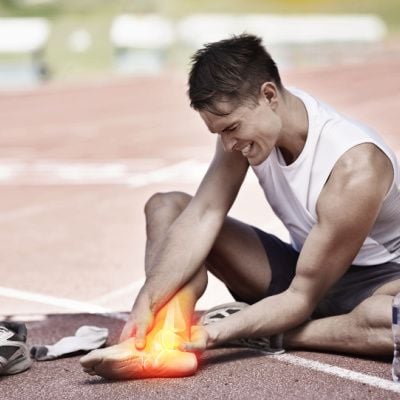Sports Injuries
- Created in Fitness and Your Feet
 Engaging in sports brings joy, competition, and physical activity into our lives, but it also comes with the inherent risk of injuries. Regarding sports injuries, the foot is a vulnerable area that frequently bears the brunt of intense athletic activities. In this comprehensive guide, we explore the landscape of sports injuries in the foot, shedding light on common types, prevention strategies, and effective treatment modalities.
Engaging in sports brings joy, competition, and physical activity into our lives, but it also comes with the inherent risk of injuries. Regarding sports injuries, the foot is a vulnerable area that frequently bears the brunt of intense athletic activities. In this comprehensive guide, we explore the landscape of sports injuries in the foot, shedding light on common types, prevention strategies, and effective treatment modalities.
Common Types of Sports Injuries
a. Ankle Sprains: Ankle sprains are prevalent in various sports and occur when the ligaments supporting the ankle are stretched or torn. Sudden changes in direction or uneven surfaces can contribute to these injuries.
b. Stress Fractures: Repetitive impact in activities like running can lead to stress fractures in the foot. These bone microcracks can cause pain and may necessitate rest and rehabilitation.
c. Plantar Fasciitis: Plantar fasciitis involves inflammation of the plantar fascia, a band of tissue connecting the heel to the toes. It often results from overuse, causing heel pain, especially during the first steps in the morning.
d. Achilles Tendonitis: The Achilles tendon, essential for activities like running and jumping, is susceptible to inflammation, known as tendonitis. Overuse or sudden increases in activity can contribute to this condition.
Preventing Sports Injuries
a. Proper Warm-Up and Stretching: A thorough warm-up routine is a crucial aspect of injury prevention. Dynamic stretching prepares the muscles and ligaments for the demands of physical activity, reducing the risk of strains.
b. Appropriate Footwear: Wearing footwear designed for specific sports and activities provides essential support and cushioning. Well-fitted shoes can mitigate impact and enhance stability during movement.
c. Gradual Progression: Avoiding sudden spikes in training intensity or duration is key to preventing overuse injuries. Gradual progression allows the body to adapt to increased demands, reducing the likelihood of stress-related injuries.
d. Strength and Conditioning: Incorporating strength and conditioning exercises into a regular fitness regimen can enhance the resilience of muscles and tendons, providing a protective buffer against injuries.
Immediate Care for Foot Injuries
a. Rest: Upon sustaining a foot injury, immediate rest is crucial. This minimizes further damage and allows the body to initiate the healing process.
b. Ice: Applying ice to the injured area helps reduce inflammation and numbs pain. Ice packs should be wrapped in a thin cloth to prevent frostbite.
c. Compression: Compression, achieved through bandages or wraps, helps control swelling and supports the injured foot.
d. Elevation: Elevating the injured foot above heart level aids in reducing swelling by allowing fluids to drain away from the affected area.
Professional Intervention: Seeking Medical Attention
While some sports injuries respond well to self-care, others may require professional evaluation and treatment. Consultation with a healthcare provider, particularly in the case of severe pain, persistent swelling, or difficulty bearing weight, is essential. Diagnostic tools like X-rays or MRI scans may be employed to assess the extent of the injury and guide the treatment plan.
Rehabilitation and Beyond
Effective rehabilitation is crucial for recovering from sports injuries in the foot. Physical therapy exercises, targeted at strengthening the affected area, improving flexibility, and restoring normal gait, play a pivotal role in recovery. Compliance with rehabilitation plans and gradual return to activity are essential to prevent re-injury.
Conclusion
Sports injuries in the foot are an unfortunate but common aspect of an active lifestyle. By understanding the types of injuries, implementing preventive measures, and seeking prompt and appropriate care when needed, individuals can foster foot health and enjoy the benefits of sports without compromising their overall well-being. Remember, a balanced approach that combines proactive injury prevention, immediate care, and professional intervention when necessary ensures a resilient foundation for an active and fulfilling athletic journey.
Disclaimer:
The information on this website is provided for educational and information purposes only and is not medical advice. Always consult with a licensed medical provider and follow their recommendations regardless of what you read on this website. If you think you are having a medical emergency, dial 911 or go to the nearest emergency room. Links to other third-party websites are provided for your convenience only. If you decide to access any of the third-party websites, you do so entirely at your own risk and subject to the terms of use for those websites. Neither Florida Foot & Ankle Associates LLC, nor any contributor to this website, makes any representation, express or implied, regarding the information provided on this website or any information you may access on a third-party website using a link. Use of this website does not establish a doctor-patient relationship. If you would like to request an appointment with a health care provider, please call our office at (954) 888-1444.